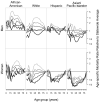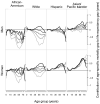Racial and social class gradients in life expectancy in contemporary California
- PMID: 20171001
- PMCID: PMC2849870
- DOI: 10.1016/j.socscimed.2010.01.003
Racial and social class gradients in life expectancy in contemporary California
Abstract
Life expectancy, or the estimated average age of death, is among the most basic measures of a population's health. However, monitoring differences in life expectancy among sociodemographically defined populations has been challenging, at least in the United States (US), because death certification does not include collection of markers of socioeconomic status (SES). In order to understand how SES and race/ethnicity independently and jointly affected overall health in a contemporary US population, we assigned a small-area-based measure of SES to all 689,036 deaths occurring in California during a three-year period (1999-2001) overlapping the most recent US census. Residence at death was geocoded to the smallest census area available (block group) and assigned to a quintile of a multifactorial SES index. We constructed life tables using mortality rates calculated by age, sex, race/ethnicity and neighborhood SES quintile, and produced corresponding life expectancy estimates. We found a 19.6 (+/-0.6) year gap in life expectancy between the sociodemographic groups with the longest life expectancy (highest SES quintile of Asian females; 84.9 years) and the shortest (lowest SES quintile of African-American males; 65.3 years). A positive SES gradient in life expectancy was observed among whites and African-Americans but not Hispanics or Asians. Age-specific mortality disparities varied among groups. Race/ethnicity and neighborhood SES had substantial and independent influences on life expectancy, underscoring the importance of monitoring health outcomes simultaneously by these factors. African-American males living in the poorest 20% of California neighborhoods had life expectancy comparable to that reported for males living in developing countries. Neighborhood SES represents a readily-available metric for ongoing surveillance of health disparities in the US.
Copyright 2010 Elsevier Ltd. All rights reserved.
Figures


References
-
- Arriaga EE. Measuring and explaining the change in life expectancies. Demography. 1984;21(1):83–96. - PubMed
-
- Berkman LF, Macintyre S. The measurement of social class in health studies: old measures and new formulations. In: Kogevinas M, Pearce N, Susser M, Boffetta P, editors. Social Inequalities and Cancer. International Agency for Research on Cancer; Lyon: 1997. pp. 51–64. - PubMed
-
- Clarke CA, Glaser SL, Keegan TH, Stroup A. Neighborhood socioeconomic status and Hodgkin's lymphoma incidence in California. Cancer Epidemiol Biomarkers Prev. 2005;14(6):1441–1447. - PubMed
-
- Deming WE, Stephan FF. On a Least Squares Adjustment of a Sampled Frequency Table When the Expected Marginal Totals are Known. The Annals of Mathematical Statistics. 1940;11(4):427–444.
Publication types
MeSH terms
Grants and funding
LinkOut - more resources
Full Text Sources
Medical
Miscellaneous

